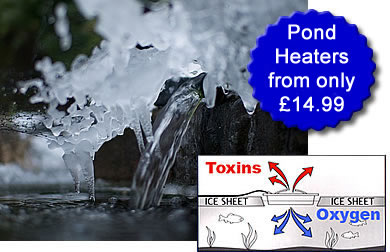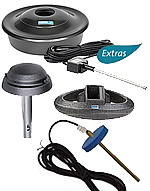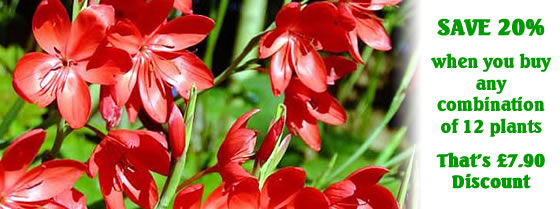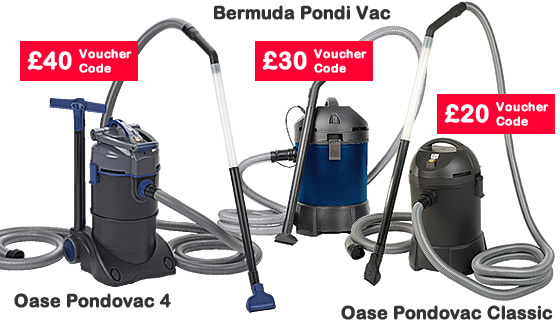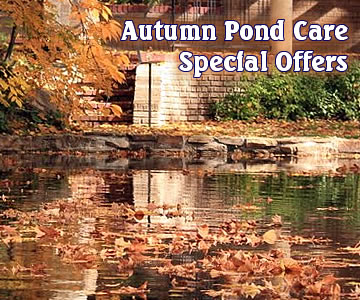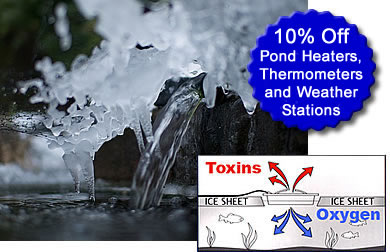 |
Get an EXTRA 10% Discount off all these Winter Products
|
|
|
|
|
|
|
|
|
|
|
Winter will soon be here.
As any Koi keeper (from amateur enthusiast to professional breeder) will tell you, UK Winters provide a different set of challenges. Koi themselves aren’t native to the UK and so some care needs to be taken to ensure their comfort and survival.
What happens to Koi in Winter that is different from other times of year?
As soon as the water temperature falls below 5 degrees C, it becomes harder for the fish. Their systems begin to shut down to conserve vital energy level, not moving unless they really have to. It is nature’s way of enabling the Koi to cope with the demands of a climate they are not accustomed to. Luckily, they are extremely hardy and versatile creatures and have coped in every water system across the globe, with Antarctica being the only exception. At less than 5 degrees C, the Kio’s immune system is very low, which is why you can have problems with parasites and infections in the Springtime when the fish start to become active again.
Koi are ‘poikilothermic’, meaning cold-blooded and their body temperature is dictated by the surrounding water; telling their body functions when to respond and change, all regulated by the temperature. The metabolism of a Koi is dramatically reduced when they do not feed for long periods of time, as nature tells them to start limiting energy expenditure to cope with the demands of a cold environment which will last for an unknown period of time.
As the Koi’s metabolism slows to a crawl, they seek pockets of warmer water in the pond, where they will spend the majority of their time through the coldest months. They may appear torpid, even static, however they will move a small amount to prevent their joints from seizing. The state or torpor they are in is not quite fully-fledged hibernation, but it is similar, with reduced body temperature, slowed metabolism, reduced breathing rate, slower reaction times and primary body functions. They are almost treading water on the bottom, using as little energy as is possible. You may see Koi lined up side by side like soldiers, all facing the same direction. A common misconception is they are ‘huddled’, sharing body heat, but since they are ‘poikilothermic’ it wouldn’t make sense that they can share core body temperature like a Human could. It is more likely they are cramming into the warmest pocket of water, fitting as many as possible into the space. This process would be the same in a 1000 gallon pond or a 60 acre lake.
The above is extracted from an article written by Shaun Mitchell of Mitchkoi, the UK’s leading online Koi carp brand – Quality Koi delivered to your door.
With the above in mind what can a pond keeper do to help Koi in Winter?
Keep track of water and air temperatures using Digital Thermometer
Ideally you should have two thermometers; one for the water in the pond and one for the outside ambient temperature. The ambient temperature is a good indicator of where the weather is heading and what you should be doing in preparation for even colder weather well in advance. When temperatures start to fall below 12 degrees C, special care should be taken when making decisions regarding feeding and pond care.
Preventive Treatments – Formalin and Malachite Green
Many people believe it is a good idea to use a good general purpose treatment such as Formalin and Malachite Green before the cold snap sets in. Any issues that Koi have pre-winter can fester during the colder months and can worsen and become harder to treat. If you treat the problem beforehand you can reduce this risk and can ease the Koi through the cold weather. The thermometer will provide you with a guide as to whether you can treat your pond, however you should remember that many treatments will become less effective as the water temperature drops.
Minimize Chilling of the Water
Although the amount of Oxygen in the water is a much smaller problem in lower temperatures than in the summer, ensuring that the pond dose not freeze over, which would prevent Oxygen getting in and trap toxic gases inside is essential. To do this, continuing to circulate the water can greatly help. However leaving you air stones / discs at the base of your pond can create real problems as the rising bubbles will bring the warmer water at the base of the pond up to the surface where it is coldest. The same principle applies to water pumps, although circulating the pond water is still beneficial, moving your water pump and air stones / discs nearer to the surface of the pond will reduce there chilling effect. Waterfalls and skimmers should also be turned off in the winter as they can also chill the water.
Alternatively, the introduction of a small pond heater or ice preventer will keep an area of the pond free from ice and ensure good gas exchange
Warning – If you do get ice formation on your pond, do not smash the ice, as it can shock and kill your Koi.
Careful Feeding – Wheatgerm based foods
In the winter months, it is key to avoid overfeeding your Koi as the metabolism slows, their ability to digest a high protein growth food dwindles. It is wise to switch to an easy-to-digest Wheatgerm base food, and to feed the Koi less frequently. When the average temperature drops below 5 degrees C we suggest you stop feeding for the rest of the winter and restart feeding with Wheatgerm when temperatures rise in the spring.
|


